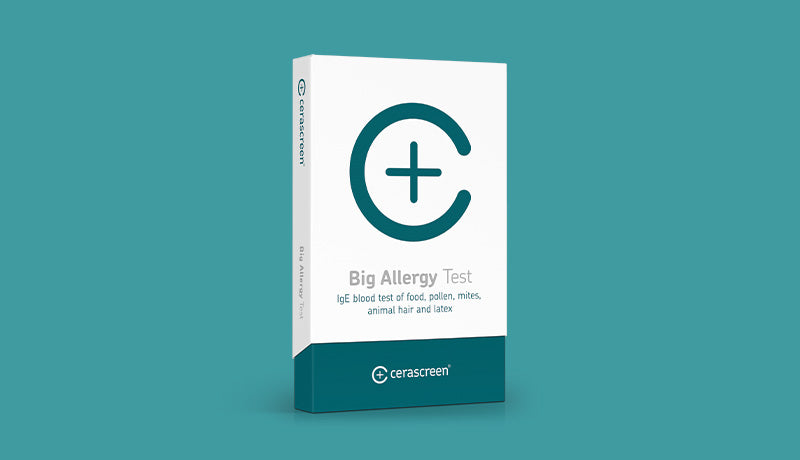What is cross-sensitivity and what has it got to do with food allergies and intolerances? An allergy rarely comes alone: if you suffer from a pollen allergy, for example, and suddenly can no longer tolerate apples, nuts or stone fruit, this is what we call a cross-allergy, cross-sensitivity or cross-reactivity.
Whether it’s the combination of birch and apple, of dust mites and prawns or of latex and tomatoes – with a cross-allergy, your body sometimes reacts to foods that at a first glance have nothing to do with the substances that trigger your known allergy. The reason behind this is that the protein particles of birch pollen and an apple, for example, are so similar that the immune system sometimes cannot distinguish between them and fights them equally.
From allergy symptoms such as a tingling sensation in the mouth, an itchy tongue and swollen lips and eyelids – experts estimate that up to 60 per cent of food allergies are related to inhalant allergens (such as pollen or house dust mites).[1]
In this article, let us take you through several questions you may have about cross-allergies. For example, how do cross-allergies develop, what happens in the body during a cross-allergic reaction, and what are the most common cross-allergies? How can I get tested for cross-reactivity? Receive practical tips from us on how to manage and relieve those pesky allergy symptoms.
What is cross-sensitivity?
With a cross-allergy, the body reacts not only to already known allergy-triggering substances, such as those contained in pollen, latex or house dust mites, but also to certain foods whose ingredients have a similar structure. The immune system confuses the substances with each other.[2] People affected by certain allergies therefore also develop a food allergy, which experts call a secondary food allergy.
With an allergy, the body reacts to what are actually harmless proteins, the allergens. It classifies them as dangerous and triggers an allergic reaction. Read more about food allergies and food intolerances in our Health Portal.

What happens in the body during a cross-reaction?
With cross-reactivity, an allergic reaction takes place in the body. What’s peculiar about this is that the body’s defensive reaction is not triggered by the actual allergen (such as pollen), but by another substance, which the immune system mistakes for the allergen.
If you are allergic to birch pollen, for example, special IgE antibodies are present in your blood. These antibodies bind the protein components of the birch pollen as soon as they enter your body. The body then releases various messenger substances that set the allergic reaction in motion. You will then notice typical allergy symptoms such as a cold and watery eyes.
In the case of a cross-sensitivity to apples, your IgE antibodies also react to protein components of the apple. The antibodies find similar binding sites on the apple substance as on birch pollen, to which they can dock and thus trigger an allergic reaction.[3]
What are the symptoms of a cross-reactivity allergy?
Cross-reactivity usually involves only mild symptoms. However, severe allergic reactions are possible – especially, if the affected person eats large quantities of the allergenic food. Symptoms usually appear a few minutes to two hours after the food has been eaten on the parts of the body that have come into direct contact with the food in question. Typical symptoms include:[4]
- Itching or tingling on the lips, tongue, palate, ears and throat.
- Redness, swelling and blistering on the mucous membranes of the mouth.
- Itchy, red, swollen lips, tongue, skin and throat
- In rare cases, gastrointestinal complaints and cardiovascular problems may also occur.

What are the most common cross-sensitivities?
You may be surprised to hear that cross-allergy sufferers can no longer tolerate certain fruit. Cross-allergies such as birch fruit syndrome and latex-fruit syndrome are commonly known for their cross-allergic reactions – here is a list of common cross-sensitivities with food:[4]
|
Main allergy |
Possible cross-sensitivity |
|
Tree pollen (for example, birch or hazel) |
Apple, peach, plum, nectarine, kiwi, cherry, pear, almond, hazelnut and other nuts, carrot, celery, potato (raw), soy, lychee |
|
Ambrosia |
Melon, banana, tomato, cucumber |
|
Mugwort |
Carrot, celery, cumin, parsley, coriander, anise, fennel seeds, mango, grape, lychee, sunflower seeds |
|
Latex |
Banana, avocado, potato, tomato, kiwi, pineapple, chestnut, buckwheat flour, celery, fig |
Did you know that some types of fruit are better tolerated than others? If you have a cross-allergy to apples, this does not mean that you have to completely eliminate apples from your diet! You can investigate which apple variety you tolerate more than others.
What foods can trigger a latex allergy?
Latex is a natural rubber substance that is found in many everyday products, including balloons, rubber bands, condoms, and rubber gloves. Many people who suffer from a latex allergy also have a hypersensitivity to some fruits – we call this cross-reactivity allergy “latex-fruit syndrome” or “latex-fruit allergy.” In fact, this is said to affect 30 to 50 per cent of individuals who are allergic to latex.[8]
Latex-reactive fruits and other foods that someone with latex-fruit syndrome may need to avoid include avocado, banana, chestnut, kiwi, peach, tomato and potato – although this is not an extensive list. If you are unsure about whether you are also sensitive to these foods, you can discuss latex allergy testing with a doctor or nutritionist.
Which other allergens are responsible for cross-reactions?
Cross-reactions in connection with a house dust allergy or animal hair allergy (such as a dog hair allergy) are rarer. Here, you will find an overview of rare cross-sensitivities:[4, 5]
|
Main allergy |
Possible cross-sensitivity |
|
Prawns, crabs, lobsters, shrimps, snails, mussels, oysters, squid |
|
|
Pollen from grasses and cereals (for example, wheat and rye) |
Spelt, barley, oats, millet, maize, wheat, rye (also flours and bran obtained therefrom), tomato, pulses |
|
Bird allergens (feathers, droppings) |
Egg, poultry, offal |
|
Animal hair |
Cow’s milk, meat, offal |
How do you test cross-reactivity?
If you suffer from an allergy and suspect that you are also no longer able to tolerate certain foods, you should first keep a food and symptom diary. Alternatively, you could – under the supervision of a doctor or nutritionist – follow an elimination diet, during which you cut out all suspected problem foods for a set amount of time before reintroducing them into your diet. This can help you to identify possible cross-sensitivities. In addition, discuss your symptoms with your doctor.
A cross-allergy can then be tested by a skin prick test or a blood test. Through these common allergy tests, you can determine whether your body is sensitised to certain allergens – that is, by forming antibodies against them.[4]
You will find that there are already several send-in home blood tests available out there, with which you can test yourself for sensitivities to various allergens. With such test kits, you usually need only take a small blood sample at home and send it to a specialised medical laboratory. With certain food intolerance tests and food allergy tests, the laboratory analyses the concentration of IgE antibodies against different food antigens and the concentration of IgG4 antibodies against various food sensitivities. You should check which food sensitivities are tested for when you purchase a test online.
Experts only diagnose an allergy if the skin or blood test is positive and allergy symptoms occur at the same time. If you are sensitised to certain substances in food, this does not necessarily mean that you cannot tolerate them.[6]
How do you test cross-reactivity?
If you have been diagnosed with a cross-sensitivity, doctors generally recommend avoiding the food in question.[7]
However, it is best to seek advice from a qualified nutritionist about your cross-allergy. Nutritionists will make sure that you are getting enough nutrients and will discuss your individual options with you. You might find that it is actually enough to prepare the food differently or to avoid only certain types.
Did you know that the allergen content of food can vary greatly. It depends, among other things, on the degree of ripeness, the variety, the region, and the method of preparation?[7]

The following cross-reaction tips may also be interesting to you:[6]
- Allergenic substances in food are destroyed by heating or acidifying. An apple compote or a cherry pie, for example, are often well tolerated.
- People with a pollen allergy are usually allergic to certain foods during the pollen seasons. So you may not be able to tolerate an apple in spring but have no problems in autumn.
- Avoid stress and alcohol. Both can aggravate the allergy.
- Physical exertion such as exercise can make an allergic reaction worse. Do not eat any problematic foods before, after or during exercise.
- The symptoms of a cross-allergy can also be treated with various medications (such as antihistamines). Ask your doctor for advice on this.[7]
What is cross-sensitivity – at a glance
What is cross-sensitivity?
With a cross-allergy, your immune system confuses substances from food (such as from the apple) with substances that trigger an allergy of which you may already be aware (for example, birch pollen).
You develop a food allergy to certain foods (apples in this case) in addition to your primary allergy (birch pollen in this case).
What are the symptoms of a cross-reaction?
A cross-reaction usually involves mild symptoms, but severe allergic reactions are possible. A few minutes to two hours after ingestion, those affected notice symptoms such as itching, tingling, redness and swelling in the mouth, throat and ears.
In rare cases, gastrointestinal discomfort and cardiovascular problems may also occur.
How do you test cross-reactivity?
A cross-sensitivity can be detected by a skin prick test or a blood test. This can check whether your body is sensitised to certain allergens – that is, by forming antibodies against them.
An allergy is present if the skin or blood test is positive and allergy symptoms occur at the same time.
Can you treat a cross-reactivity allergy?
If you have a cross-allergy, such as latex-fruit syndrome, you should always avoid the problematic food.
Seek advice from a nutritionist. It is often enough to prepare the food differently, to avoid only certain types, or to take the season into account.
Avoid stress and alcohol.
Sources
[1] Werfel, T. et al, ‘Position paper of the EAACI: food allergy due to immunological cross-reactions with common inhalant allergens’, Allergy, vol. 70(9), p. 1079–1090, 2015, doi: https://doi.org/10.1111/all.12666.
[2] European Centre for Allergy Research Foundation (Stiftung ECARF), ‘Kreuzreaktion (Kreuzallergie)’, ECARF - For a Better Life with Allergies, available at https://www.ecarf.org/kreuzreaktion-kreuzallergie/, accessed on 1 February 2021.
[3] Wagner, B. ‘Was ist eine Kreuzallergie? - LZG (DE)’, Landeszentrale für Gesundheitsförderung in Rheinland-Pfalz e.V., 1 October 2016, available at https://www.lzg-rlp.de/de/event/was-ist-eine-kreuzallergie.html, accessed on 2 February 2021.
[4] Zuberbier, T. ‘Sellerie, Kirschen & Co. - Kreuzallergien’, European Centre for Allergy Research Foundation (Stiftung ECARF), November 2016, available at https://www.ecarf.org/info-portal/allergien/sellerie-kirschen-garnelen-kreuzallergien/, accessed on 2 February 2021.
[5] ‘Kreuzallergie - Wichtige Informationen’, Bundesministerium für Soziales, Gesundheit, Pflege und Konsumentenschutz, 25 September 2018, available at https://www.gesundheit.gv.at/krankheiten/allergie/nahrungsmittelallergie/kreuzallergie, accessed on 3 February 2021.
[6] ‘Durch Heuschnupfen verursachte Nahrungsmittelallergie - Kreuzallergie’, Deutscher Allergie- und Asthmabund e.V., available at https://www.daab.de/ernaehrung/nahrungsmittel-allergien/ausloeser/kreuzallergie/, accessed on 3 February 2021.
[7] Allergieinformationsdienst - Helmholtz Zentrum München, ‘Nahrungsmittel als Allergene und Kreuzallergien’, 6 June 2019, available at https://www.allergieinformationsdienst.de/immunsystem-allergie/allergene/nahrungsmittel.html, accessed on 8 February 2021.
[8] Wagner S., Breiteneder H. “The latex-fruit syndrome.” Biochem Soc Trans. 2002, 30(Pt 6), pp. 935–940, doi:10.1042/bst0300935.



